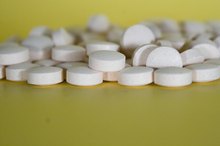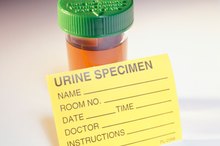Normal Range of Uric Acid Levels in the Blood
Uric acid forms when purines break down in the body. Purines come from certain foods such as organ meats, asparagus, spinach, lentils, beer or wine as well as from the breakdown of proteins in the body. Higher than normal uric acid levels can cause gout, an inflammatory arthritis in the large joints, kidney stones Uric acid levels can vary widely from day to day.
If you are experiencing serious medical symptoms, seek emergency treatment immediately.
Normal Range
Adult men normally have uric acid levels between 2 and 7.5 mg/dL, while adult women normally have levels between 2 and 6.5 mg/dL. Boys between the ages of 10 and 18 have levels of 3.6 to 5.5 mg/dL and girls levels fall between 3.6 and 4 mg/dL. In men older than age 40, levels range between 2 to 8.5 mg/dL and in women older than 40, between 2 and 8 mg/dL, according to RnCeus.com. Women's levels rise after menopause.
- Adult men normally have uric acid levels between 2 and 7.5 mg/dL, while adult women normally have levels between 2 and 6.5 mg/dL.
- Boys between the ages of 10 and 18 have levels of 3.6 to 5.5 mg/dL and girls levels fall between 3.6 and 4 mg/dL.
- In men older than age 40, levels range between 2 to 8.5 mg/dL and in women older than 40, between 2 and 8 mg/dL, according to RnCeus.com.
Causes of High Levels
What Is Naproxen 500 mg Used for?
Learn More
High levels of uric acid can occur from a number of causes. Both overproduction of uric acid or decreased excretion through the kidney or stool can cause higher than normal uric acid levels. The kidneys excrete two-thirds of excess uric acid, while one-third passes through the stools, RnCeus.com states 2. Excess alcohol consumption, use of diuretics, diabetes, lead poisoning, kidney disease, cancer, toxemia of pregnancy or high purine intake can cause high uric acid levels. Some people have a family tendency toward high uric acid levels. Many drugs, including aspirin, caffeine, theophylline or phenothiazides can causes elevated levels.
- High levels of uric acid can occur from a number of causes.
- Both overproduction of uric acid or decreased excretion through the kidney or stool can cause higher than normal uric acid levels.
Causes of Low Levels
Low levels of uric acid are less common than high levels and usually not serious. Diseases such as Fanconi syndrome, syndrome of inappropriate diuretic hormone secretion, also called SIADH, or liver diseases such as Wilson’s disease can cause low uric acid levels. Low purine intake can also cause low uric acid levels. Some drugs, such as:
- allopurinol
- used to treat gout
- corticosteroids
- estrogen
- glucose
- warfarin can also lower serum uric acid levels
Pregnant women may experience a temporary fall in uric acid levels by around 33 percent, but levels return to normal by the end of pregnancy.
- Low levels of uric acid are less common than high levels and usually not serious.
- Some drugs, such as: * allopurinol
* used to treat gout
* corticosteroids
* estrogen
* glucose
* warfarin can also lower serum uric acid levels Pregnant women may experience a temporary fall in uric acid levels by around 33 percent, but levels return to normal by the end of pregnancy.
Considerations
Fish That Are High in Purines
Learn More
High uric acid levels don’t always result in symptoms. If uric acid crystals accumulate in large joints, most often the big toe, they cause pain, redness and swelling called gout. Decreasing purine intake in the diet to 100 to 150 mg per day by reducing high-purine foods can reduce the risk of developing gout and kidney stones from high uric acid levels. Food that contain purine levels of more than 100 mg include all organ meats, anchovies, bacon, goose, veal, venison and fish such as:
- haddock
- codfish
- mackerel
- herring
- High uric acid levels don’t always result in symptoms.
- Decreasing purine intake in the diet to 100 to 150 mg per day by reducing high-purine foods can reduce the risk of developing gout and kidney stones from high uric acid levels.
Related Articles
References
- MedlinePlus; Uric Acid-Blood; David C. Dugdale, III, M.D; May 2009
- RnCeus.com; Uric Acid; 2006
- Litholink; Low Purine Diet; 2003
- George C, Minter DA. Hyperuricemia. [Updated 2019 Jun 4]. In: StatPearls [Internet]. Treasure Island (FL): StatPearls Publishing; 2019 Jan-.
- American Association for Clinical Chemistry. Uric acid. Reviewed May 17, 2017.
- Benn CL, Dua P, Gurrell R, et al. Physiology of hyperuricemia and urate-lowering treatments. Front Med (Lausanne). 2018;5:160. doi:10.3389/fmed.2018.00160
- George C, Minter DA. Hyperuricemia. [Updated 2019 Jun 4]. In: StatPearls [Internet]. Treasure Island (FL): StatPearls Publishing; 2019 Jan-.
- Ramirez-Sandoval JC, Madero M. Treatment of hyperuricemia in chronic kidney disease. Contrib Nephrol. 2018;192:135-146. doi: 10.1159/000484288
- Wilson FP, Berns JS. Tumor lysis syndrome: new challenges and recent advances. Adv Chronic Kidney Dis. 2014;21(1):18–26. doi:10.1053/j.ackd.2013.07.001
- American Association for Clinical Chemistry. Uric acid. Reviewed May 17, 2017.
- Khanna D, Fitzgerald JD, Khanna PP, et al. 2012 American College of Rheumatology guidelines for management of gout. Part 1: systematic nonpharmacologic and pharmacologic therapeutic approaches to hyperuricemia. Arthritis Care Res (Hoboken). 2012;64:1431–46. doi: 10.1002/acr.21772
- Coburn BW, Bendlin KA, Sayles H, et al. Target serum urate: Do gout patients know their goal? Arthritis Care Res (Hoboken). 2016;68(7):1028-35. doi:10.1002/acr.22785
- Wiederkehr MR, Moe OW. Uric acid nephrolithiasis: a systemic metabolic disorder. Clin Rev Bone Miner Metab. 2011;9(3-4):207–217. doi:10.1007/s12018-011-9106-6
Writer Bio
A registered nurse with more than 25 years of experience in oncology, labor/delivery, neonatal intensive care, infertility and ophthalmology, Sharon Perkins has also coauthored and edited numerous health books for the Wiley "Dummies" series. Perkins also has extensive experience working in home health with medically fragile pediatric patients.









